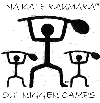
THE HANA HOU SERIES Wahine o Hawai`i © 1999 Kawika Sands |

THE HANA HOU SERIES Wahine o Hawai`i © 1999 Kawika Sands |
|
INTRODUCTION The Hawaiian woman's lifestyle was primitive by comparison. Walking around half naked, beating kapa for the family clothing and bedding, weaving lauhala mats, gathering limu (seaweed) and freshwater fish, and bringing up the children. Her tools were anything but fancy. Poi ponders, kapa beaters, gourds, bowls, coconut dishes, stone lamps with kukui nuts burning in them for light though it was generally the children's duty to keep them burning. Getting dressed was somewhat different for these Hawaiian women. They wore a skirt made from five thicknesses of kapa called the pa`u. By having an attendant or two hold one end on the ground, she rolled herself up into it. Considering her size, it was probably the most streamlined method. It was a humble existence, yet she was freer and more liberated than her sisters across the sea. Today's societal ideal of the beautiful woman was not that of old Hawaiian society. The Chiefess was considered most beautiful if she were at least six feet tall, and almost half as wide. In old Polynesia, fat meant survival particularly when it came to the long ocean crossings. Something Herb Kane suggested in the early days of the sailing canoe Hokule`a, further suggesting that this may have actually helped to determine the general physical stature of the Polynesian. Basically, it was the bigger, the better and the women were fed to stay that way! Hawaiian women swam, surfed, climbed, fished, ran, and were active in sports while her western sister laced herself into a faint. She too paddled and steered outrigger canoes if the kapu allowed. She would even fight beside her Hawaiian brothers (although it was not generally encouraged). One of the best known and glorious battles of ancient Hawai`i was the battle of Nuuanu. The final battle on O`ahu whereby King Kamehameha stepped upon the threshold of uniting the Hawaiian Islands. There, the Chiefesss took up arms against the invading king's forces. Wearing helmets and feathered cloaks, they picked up spears and clubs, and fought to the death along side the men. It was only after the battle was won that Kamehameha found that some of the warriors who had fought so valiantly were actually women. Men did the cooking. Something Hawaiian women took pity on her missionary sisters for as men were the ones who stood over hot "stoves" and cooked. Actually, building the imu (an earthen oven dug into the ground and lined with stones), opening coconuts, etc. was hard work so these chores fell upon the men.
|

Last Modified: Saturday - 19991113.12:36 EST
Copyright © 1999 Kawika Sands
Produced online by HoloHolo Internet Publishing all rights reserved